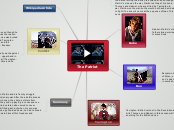Theoretical approaches to
Health and Disease
Reference
Pandey, M. 2016. Health- A Sociological Perspective: An Overview. International Journal for innovative research in multidisciplinary field, 2(10): 2455-0620. [Online]. Available at: https://www.ijirmf.com/wp-content/uploads/2016/11/201610046.pdf [Accessed 31 August 2023].
Stewart, P. and Zaaiman, J. eds. 2018. Sociology: A concise South African introduction. Cape Town: Juta and Company.
Reference
Pandey, M. 2016. Health- A Sociological Perspective: An Overview. International Journal for innovative research in multidisciplinary field, 2(10): 2455- 0620. [Online]. Available at: https://www.ijirmf.com/wp-content/uploads/2016/11/201610046.pdf [Accessed 31 August 2023].
Stewart, P. and Zaaiman, J. eds. 2018. Sociology: A concise South African introduction. Cape Town:
Symbolic Interactionism
Approach
- Interaction theory or approach focuses mainly on small-scale interaction instead of society as a whole and mostly rejects the notion of the social system (Pandey, 2016).
- Max Weber (1864-1920) and Erving Goffman (1922-1982) were the two main theorist in symbolic interactionism approach (Stewart & Zaaiman, 2018).
- The symbolic interactionism approach sees humans as acting instead of being acted upon (Stewart & Zaaiman, 2018).
-This approach emphasizes that illness and health are social constructs meaning, physical and medical conditions have small or no objective reality however considered healthy or ill conditions if they are only defined by a society and its members (Pandey, 2016).
Conflict
Approach
- Back then, mortality was labelled as result of infectious diseases such as cholera, dysentery, plagues, tuberculosis, syphilis and gangrene (Stewart & Zaaiman, 2018).
- However, these infectious diseases did not discriminate between class members who were impoverished and members who were in affluent classes (Stewart & Zaaiman, 2018).
- Stewart and Zaaiman (2018) further states that therefore individuals and groups within society must compete for limited resources like wealth, leisure and sexual partners.
- However, social inequality influences health and healthcare (Pandey, 2016).
- Within the conflict approach, Marxian theory or rather stratification of society was an observation that in order to survive, man should produce their foods and material objects, develop and go into social relationships with other people (Pandey, 2016)
- Pandey (2016) further states that conflict perspective or approach dwells in the analysis of infrastructure.
- The conflict approach emphasizes on inequality and injustice, which are sources of conflict that infiltrate society (Stewart & Zaaiman, 2018).
- Due to disparities in resource and power distribution within society, certain individuals and institutions possess more material goods, power, influence and prestige than others (Stewart & Zaaiman, 2018).
- The economic development contributed within society's improvements in diets as an agricultural technique which has developed, transportation in production became quick and more efficient (Stewart & Zaaiman, 2018).
-
Structural Functionalism
Approach
- Eiether consciously or unconsciously, most people use ill health or illness as an excuse to allow ill health to impair people's abilities to perform their social roles and responsibilities (Pandey, 2016). - Thereby it's important to maintain sickness because too much disease would cause dysfunction and disruption within society as a whole (Stewart & Zaaiman, 2018).
2. The sick person is not held accountable for the ill health and society agrees that the sick individual should be taken care of by others such as the healthcare professionals (Stewart & Zaaiman, 2018)
3. The sick individual is warned to not get so attached to the sick role or enjoy the lifting of responsibilities that he/she loses motivation to get better (Stewart & Zaaiman, 2018).
4. The sick individual is expected to seek medical advice and participate with healthcare professionals (Stewart & Zaaiman, 2018).
- Parsons developed the concept of the sick role in order to analyze and examine sickness as a societal role and was led to develop it due the cognizance of how society allowed illness (Stewart & Zaaiman, 2018). In order for society to function accordingly, illness needs to be controlled to such an extent that societal members are able to continue their social roles and obligations (Stewart & Zaaiman, 2018)
-Society allowed individuals who accepted the sick role to gain 2 benefits and to also impose 2 critical behavioral requirements (Stewart & Zaaiman, 2018) namely;
1. The sick individual is given permission to be excused (temporarily) from social responsibilities however, society needs a physician's validation of the issue in order to maintain control and prevent other people from wondering in the sick role (Stewart & Zaaiman, 2018).
- Talcott Parsons (1951), a man that developed the concept of the sick role and utilized the structural functionalist perspective into the study of health and disease, emphasizing the social dimensions of these phenomena (Stewart & Zaaiman, 2018).
- The concept sick role is a temporary role that encompasses societal norms in relation to how society should handle sick individuals and how other individuals who are ill should behave themselves (Stewart & Zaaiman, 2018).









